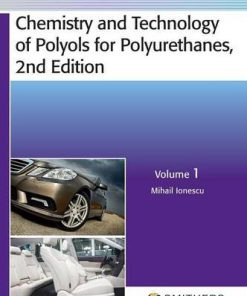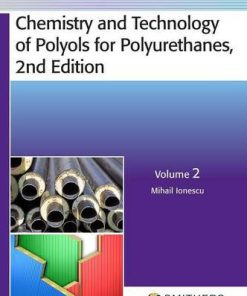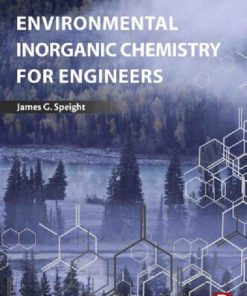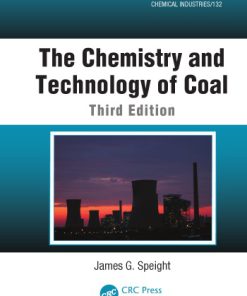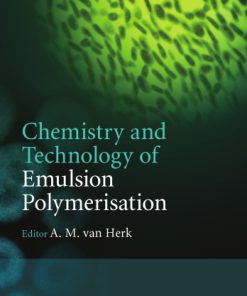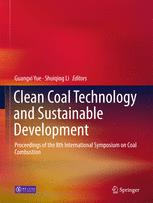The chemistry and technology of coal 1st Edition by James Speight ISBN 9781040059098 1040059090
$50.00 Original price was: $50.00.$25.00Current price is: $25.00.
The chemistry and technology of coal 1st Edition by James Speight – Ebook PDF Instant Download/Delivery: 9781040059098 ,1040059090
Full download The chemistry and technology of coal 1st Edition after payment
Product details:
ISBN 10: 1040059090
ISBN 13: 9781040059098
Author: James Speight
The chemistry and technology of coal 1st Edition Table of contents:
Chapter 1 Occurrence and Resources
1.1 Introduction
1.2 History
1.3 Rock Environment
1.4 Seam Structure
1.4.1 Shale Partings and Split Coal
1.4.2 Washouts
1.4.3 Dipping and Folded Strata
1.4.4 Faults
1.4.5 Clastic Dikes and Clay Veins
1.4.6 Fractures and Cleats
1.4.7 Concretions
1.4.8 Igneous Intrusions
1.5 Reserves
1.5.1 Proven Reserves (Proved Reserves)
1.5.2 Inferred Reserves (Unproved Reserves)
1.5.3 Potential Reserves (Probable Reserves, Possible Reserves)
1.5.4 Undiscovered Reserves
1.5.5 Coal Bed Methane
1.5.5.1 Reservoir Characteristics
1.5.5.2 Contamination
1.5.5.3 Recovery
1.6 Resources
References
Chapter 2 Classification
2.1 Introduction
2.2 Classification Systems
2.2.1 Geological Age
2.2.2 Banded Structure
2.2.3 Rank
2.2.4 Coal Survey (National Coal Board, UK)
2.2.5 International System
2.3 Correlation Of The Various Systems
2.4 Epilogue
References
Chapter 3 An Organic Sediment
3.1 Introduction
3.2 Precursors Of Coal
3.2.1 Lignin
3.2.2 Carbohydrates
3.2.3 Proteins
3.2.4 Oils, Fats, and Waxes
3.2.5 Miscellaneous Organic Materials
3.2.5.1 Resins
3.2.5.2 Tannins
3.2.5.3 Alkaloids
3.2.5.4 Porphyrins
3.2.5.5 Hydrocarbons
3.2.5.6 Inorganic Constituents (Mineral Constituents) of Plants
3.3 Coal-Forming Processes
3.3.1 Establishment of Source Beds
3.3.1.1 Transportation Theory (Allochthonous Theory)
3.3.1.2 Peat Swamp Theory (Autochthonous Theory)
3.3.2 Geochemical and Metamorphic Processes
3.4 Heteroatoms In Coal
3.4.1 Nitrogen
3.4.2 Oxygen
3.4.3 Sulfur
3.4.4 Other Elements
3.5 Epilogue
References
Chapter 4 An Organic Rock
4.1 Introduction
4.2 Physical Structure
4.3 Petrology
4.4 Petrography
4.4.1 Lithotypes
4.4.2 Macerals
4.4.2.1 Vitrinite Macerals
4.4.2.2 Liptinite Macerals
4.4.2.3 Inertinite Macerals
4.4.3 Microlithotypes
4.4.4 Inorganic Constituents
4.5 Petrology, Petrography, And Behavior
References
Chapter 5 Recovery
5.1 Introduction
5.2 Exploratory Drilling Equipment And Techniques
5.2.1 Equipment and Techniques
5.2.2 Recent Advances
5.3 Mining
5.3.1 Underground Mining
5.3.1.1 Conventional Mining
5.3.1.2 Continuous Mining
5.3.1.3 Longwall Mining
5.3.1.4 Shortwall Mining
5.3.1.5 Room and Pillar Mining
5.3.1.6 Miscellaneous Methods
5.3.2 Mine Environment
5.3.2.1 Mine Floor and Roof Strata
5.3.2.2 Gas Evolution
5.3.2.3 Rock Bursts
5.3.2.4 Coal Dust
5.3.2.5 Mine Fires
5.3.2.6 Mine Ventilation
5.3.3 Underground Transportation
5.3.4 Mine Gases
5.3.4.1 Firedamp (Methane)
5.3.4.2 Whitedamp (Carbon Monoxide)
5.3.4.3 Blackdamp (Carbon Dioxide)
5.3.4.4 Stinkdamp (Hydrogen Sulfide)
5.3.4.5 Afterdamp (Mixed Gases)
5.3.5 Mine Hazards
5.3.6 Surface Mining
5.3.6.1 Strip Mining
5.3.6.2 Open Pit Mining
5.3.6.3 Contour Mining
5.3.6.4 Auger Mining
5.3.6.5 Mountain Top Removal
References
Chapter 6 Preparation, Transportation, and Storage
6.1 Introduction
6.2 Coal Preparation
6.3 Size Reduction
6.3.1 Rotary Breaker
6.3.2 Roll Crusher
6.3.3 Hammer Mill
6.3.4 Impactors
6.3.5 Tumbling Mills
6.4 Coal Cleaning
6.4.1 Effect of Composition and Rank
6.4.2 Methods
6.4.2.1 Dense-Media Washing
6.4.2.2 Pneumatic Cleaning
6.4.2.3 Jig-Table Washing
6.4.2.4 Water Clarification
6.4.2.5 Other Processes
6.5 Coal Drying
6.6 Desulfurization
6.7 Coal Sampling
6.8 Transportation
6.8.1 Unit Train
6.8.2 Coal Barge
6.8.3 Coal Pipeline
6.8.4 Truck Transport
6.8.5 Ocean Transport
6.8.6 Conveyer Belt Transport
6.9 Storage
6.9.1 Oxidation and Spontaneous Combustion
6.9.1.1 Oxidation
6.9.1.2 Oxidation and Rank
6.9.1.3 Pyrite
6.9.1.4 Coal Size and Stockpile Ventilation
6.9.1.5 Moisture Content
6.9.1.6 Time Factor
6.9.2 Effect of Storage on Coal Properties
6.9.3 Elements of Safe Mine Storage and Reclaiming of Coal
6.9.3.1 Long-Term Storage
6.9.3.2 Short-Term Storage
References
Chapter 7 Mineral Matter
7.1 Introduction
7.2 Origin Of Mineral Matter In Coal
7.3 Occurrence
7.4 Mineral Types
7.4.1 Clay Minerals (Aluminosilicates)
7.4.2 Quartz (Silica)
7.4.3 Carbonate Minerals
7.4.4 Sulfur (Sulfide and Sulfate) Minerals
7.5 Classification
7.6 Evaluation Of Mineral Matter
7.6.1 Ashing Techniques
7.6.2 Ash Analysis and/or Direct Mineral Analysis
7.7 Chemistry Of Ash Formation
7.8 Effect Of Mineral Matter In Coal
References
Chapter 8 Coal Analysis
8.1 Introduction
8.2 Sampling
8.2.1 In Situ Sampling
8.2.2 Ex Situ Sampling
8.3 Proximate Analysis
8.3.1 Moisture
8.3.2 Natural Bed Moisture (Equilibrium Moisture, Capacity Moisture)
8.3.3 Volatile Matter
8.3.4 ASH
8.3.5 Fixed Carbon
8.4 Ultimate Analysis (Elemental Analysis)
8.4.1 Carbon and Hydrogen
8.4.2 Nitrogen
8.4.3 Sulfur
8.4.4 Oxygen
8.4.5 Chlorine
8.4.6 Mercury
8.5 Calorific Value
8.6 Reporting Coal Analyses
8.7 Precision And Accuracy
8.8 Interrelationships Of Analytical And Physical Data
References
Chapter 9 Coal Properties
9.1 Introduction
9.2 Physical Properties
9.2.1 Density (Specific Gravity)
9.2.2 Porosity and Surface Area
9.2.3 Reflectance
9.2.4 Refractive Index
9.3 Mechanical Properties
9.3.1 Strength
9.3.2 Hardness
9.3.3 Friability
9.3.4 Grindability
9.3.5 Dustiness Index
9.3.6 Cleat Structure
9.3.7 Deformation and Flow under Stress
9.4 Thermal Properties
9.4.1 Calorific Value
9.4.2 Heat Capacity
9.4.3 Thermal Conductivity
9.4.4 Plastic and Agglutinating Properties
9.4.5 Agglomerating Index
9.4.6 Free Swelling Index
9.5 Electrical Properties
9.5.1 Specific Resistance (Resistivity)
9.5.2 Electrical Conductivity
9.5.3 Dielectric Constant
9.6 Epilogue
References
Chapter 10 Organic Constituents
10.1 Introduction
10.2 Solvent Extraction
10.2.1 Soluble Constituents
10.2.2 Insoluble Constituents
10.3 Chemical Methods
10.4 Spectroscopic Methods
10.4.1 Infrared Absorption Spectroscopy
10.4.2 Nuclear Magnetic Resonance Spectroscopy
10.4.3 X-Ray Diffraction
10.4.4 Electron Spin Resonance
10.4.5 Mass Spectroscopy
10.4.6 Ultraviolet Spectroscopy
10.4.7 Electron Microscopy
10.5 Physical Property Methods
10.6 Heteroatoms
10.6.1 Nitrogen
10.6.2 Oxygen
10.6.3 Sulfur
10.7 Molecular Weight
10.7.1 Depolymerization
10.7.2 Reductive Alkylation
10.7.3 Acylation
10.7.4 Base Alcohol Hydrolysis
10.7.5 Miscellaneous Methods
10.8 Assessment Of Coal Structure
10.8.1 Elemental Analysis
10.8.2 Oxygen Functional Groups in Coal
10.8.3 Pore Structure
References
Chapter 11 Solvent Extraction
11.1 Introduction
11.2 Physicochemical Concepts
11.3 Action Of Specific Solvents
11.3.1 Influence of Coal Rank
11.3.2 Influence of Solvent Type
11.4 Composition Of The Extracts
11.5 Solvolysis
11.6 Solvent Swelling Of Coal
11.7 Epilogue
References
Chapter 12 Chemical Reactivity
12.1 Introduction
12.2 Reactions With Oxygen (Or Air)
12.2.1 Chemical and Physicochemical Aspects
12.2.2 Effect of Moisture
12.2.3 Effect of Pyrite
12.2.4 Spontaneous Ignition
12.3 Reactions With Oxidants
12.4 Bacterial Oxidation Of Coal
12.5 Hydrogenation
12.5.1 Liquid-Phase Hydrogenation
12.5.2 Vapor-Phase Hydrogenation
12.5.3 Influence of Petrographic Composition
12.5.4 Desulfurization during Hydrogenation
12.6 Halogenation
12.7 Alkylation
12.8 Depolymerization
12.9 Hydrolysis
12.10 Miscellaneous Reactions
12.10.1 Reactions of Oxygen-Containing Functional Groups
12.10.2 Reactions of Sulfur-Containing Functional Groups
12.10.3 Reactions of Nitrogen-Containing Functional Groups
12.10.4 Reactions of Mineral Matter and Trace Elements
References
Chapter 13 Thermal Reactivity
13.1 Introduction
13.2 Thermal Decomposition Processes
13.2.1 Pyrolysis
13.2.2 Carbonization
13.2.3 Flash Pyrolysis and Hydropyrolysis
13.3 Physicochemical Aspects
13.3.1 Thermal and Rheological Behavior
13.3.2 Kinetic Aspects
13.3.3 Petrographic Composition
13.4 Thermal Decomposition Products
13.4.1 Gaseous and Liquid Products
13.4.2 Solid Products
References
Part II Technology and Utilization
Combustion And Electric Power Generation
Carbonization (Briquetting And Pelletizing)
Liquefaction
Gasification
Clean Coal Technologies
Gas Cleaning
Chemicals From Coal
Environmental Aspects Of Coal Use
Energy Security
References
Chapter 14 Combustion
14.1 Introduction
14.2 Chemistry And Physics
14.2.1 Influence of Coal Quality
14.2.2 Mechanisms
14.2.3 Ignition
14.2.4 Surface Effects
14.2.5 Reaction Rates
14.2.6 Heat Balance
14.2.7 Soot Formation
14.2.8 Convection and Radiation
14.2.9 Fouling
14.2.10 Additives and Catalysts
14.2.11 Excess Air
14.2.12 Coal/Air: Transport
14.2.13 Spontaneous Combustion
14.3 Combustion Systems
14.3.1 Fixed Beds (Slowly Moving Beds)
14.3.1.1 Up-Draught Combustion
14.3.1.2 Down-Draught Combustion
14.3.2 Fluidized Beds
14.3.3 Entrained Systems
14.3.4 Miscellaneous Systems
14.3.4.1 Colloidal Fuel-Fired Units
14.3.4.2 Ignifluid System
14.3.4.3 Submerged Combustion Systems
14.3.5 Fuel Feeders
14.4 Coal–Liquid Mixtures
14.4.1 Coal–Oil Mixtures
14.4.2 Coal–Water Mixtures
14.4.3 Process Technology
14.4.4 Combustion
14.5 Coal Combustion Products
References
Chapter 15 Electric Power Generation
15.1 Introduction
15.2 Electricity From Coal
15.2.1 Coal Properties
15.2.2 Combustion Technology
15.2.2.1 Direct Combustion Technology
15.2.2.2 Fixed-Bed Combustors
15.2.2.3 Entrained Pulverized Coal Firing
15.2.2.4 Cyclone-Fired System
15.2.2.5 Tangential-Fired System
15.2.2.6 Fluidized-Bed Combustion
15.2.2.7 Arch-Fired Systems
15.2.2.8 Gas Turbine Systems
15.2.2.9 Combined-Cycle Generation
15.2.2.10 Cogeneration
15.2.2.11 IGCC Technology
15.3 Steam Generation
15.4 Power Plant Waste
15.4.1 Coal Ash
15.4.2 Flue-Gas-Desulfurization Waste
15.4.3 Waste Heat
15.5 Coal–Water Fuels
15.6 Air Pollution Control Devices
15.6.1 Nitrogen Oxide Emissions
15.6.2 Sulfur Oxide Emissions
15.7 Carbon Capture And Storage Technologies
References
Chapter 16 Carbonization
16.1 Introduction
16.2 Physicochemical Aspects
16.2.1 Effect of Coal Properties
16.2.2 Determination of Coke Properties
16.3 Process Concepts
16.3.1 Low-Temperature Carbonization
16.3.2 High-Temperature Carbonization
16.4 Coal Tar
16.5 Coke
16.6 Charcoal
References
Chapter 17 Briquetting and Pelletizing
17.1 Introduction
17.2 General Concepts
17.2.1 Coal Briquettes
17.3 Briquetting Technology
17.3.1 Briquetting Techniques
17.3.2 Technology Overview
17.3.2.1 Carbonization Stage
17.3.2.2 Forming Stage
17.4 Charcoal Briquettes
17.4.1 Raw Materials
17.4.2 Manufacturing Process
17.4.3 Feedstocks and Briquette Production
17.4.4 By-Product Waste
17.5 Bio-Briquettes
17.5.1 Production
17.5.2 Bio-Briquettes versus Coal Briquettes
17.6 Briquette Properties
17.6.1 Influence of Coal Type
17.6.2 Influence of Binder
17.6.2.1 Coal Tar
17.6.2.2 Petroleum Residua
17.6.2.3 Sulfite Liquor
17.6.2.4 Starch Materials
17.6.2.5 Lime
17.6.3 Types and Sizes
17.6.4 Mechanical and Burning Properties
17.7 Processes
17.7.1 Anthracine Process
17.7.2 Thermal Oxidation in a Sand Bed
17.7.3 INIEX Process
17.7.4 Foundry Form Coke Process
17.7.5 FMC Process
17.7.6 Ancit Process
17.8 Pelletizing
17.8.1 Cold Pelletizing
17.8.2 Hot Pelletizing
References
Chapter 18 Liquefaction
18.1 Introduction
18.2 Physicochemical Aspects
18.3 Process Classification
18.3.1 Pyrolysis Processes
18.3.2 Solvent Extraction Processes
18.3.3 Catalytic Liquefaction Processes
18.3.4 Indirect Liquefaction Processes
18.4 Reactors
18.5 Products
18.5.1 Characterization
18.5.2 Compound Types
18.5.3 Asphaltene Constituents
18.5.4 Refining
References
Chapter 19 Liquefaction Processes
19.1 Introduction
19.2 Pyrolysis Processes
19.2.1 Lurgi–Ruhrgas Process
19.2.2 Char-Oil Energy Development Process
19.2.3 Occidental Flash Pyrolysis Process
19.2.4 Toscoal Process
19.2.5 Clean Coke Process
19.2.6 Coalcon Process
19.3 Solvent Extraction Processes
19.3.1 Consol Synthetic Fuel Process
19.3.2 Costeam Process
19.3.3 Extractive Coking Process
19.3.4 Extraction by Supercritical Fluids
19.3.5 Exxon Donor Solvent Process
19.3.6 Pott–Broche Process
19.3.7 Solvent Refined Coal Process
19.3.8 Solvent Refined Lignite Process
19.3.9 UOP PROCESS
19.4 Catalytic Liquefaction Processes
19.4.1 H-Coal Process
19.4.2 Synthoil Process
19.4.3 Gulf Catalytic Coal Liquids Process
19.4.4 Multistage Liquefaction Process
19.4.5 Bergius Process
19.4.6 University of Utah Process
19.4.7 Schroeder Process
19.4.8 Liquid Phase Zinc Chloride Process
19.4.9 Miscellaneous Processes
19.5 Indirect Liquefaction Processes
19.5.1 Fischer–Tropsch Process
19.5.2 Methanol Synthesis
19.5.3 Methanol-to-Gasoline
19.6 Coal Liquids Refinery
References
Chapter 20 Gasification
20.1 Introduction
20.2 Gaseous Products
20.2.1 Low-Heat-Content Gas (Low-Btu Gas)
20.2.2 Medium-Heat-Content Gas (Medium-Btu Gas)
20.2.3 High-Heat-Content Gas (High-Btu Gas)
20.2.4 Methane
20.2.5 Hydrogen
20.2.6 Other Products
20.3 Physicochemical Aspects
20.3.1 Reactions
20.3.2 Process Concepts
20.3.2.1 Pretreatment
20.3.2.2 Primary Gasification
20.3.2.3 Secondary Gasification
20.3.2.4 Shift Conversion
20.3.2.5 Hydrogasification
20.4 Process Types And Reactors
20.4.1 Reactors
20.4.2 Process Types
20.4.2.1 Fixed-Bed Processes
20.4.2.2 Fluid-Bed Processes
20.4.2.3 Entrained-Bed Processes
20.4.2.4 Molten Salt Processes
20.5 Gasification Of Coal With Biomass And Waste
20.6 Underground Gasification
20.7 Environmental Aspects
References
Chapter 21 Gasification Processes
21.1 Introduction
21.2 Fixed-Bed Processes
21.2.1 Lurgi Process
21.2.2 Wellman–Galusha Process
21.2.3 Foster–Wheeler Stoic Process
21.2.4 Woodall–Duckham Process
21.3 Fluidized-Bed Processes
21.3.1 Winkler Process
21.3.2 Hydrane Process
21.3.3 Hygas Process
21.3.4 Synthane Process
21.3.5 U-Gas Process
21.3.6 Coalcon Process (Hydrocarbonization Process)
21.3.7 Pressurized Fluid-Bed Process
21.3.8 Carbon Dioxide Acceptor Process
21.3.9 Agglomerating Burner Process
21.3.10 COED/COGAS Process
21.3.11 Catalytic Gasification Process
21.4 Entrained-Bed Processes
21.4.1 Koppers–Totzek Process
21.4.2 Bi-Gas Process
21.4.3 Entrained-Bed Process
21.4.4 Texaco Process
21.5 Molten Salt Processes
21.5.1 Atgas Process
21.5.2 Molten Salt (Rockgas) Process
21.5.3 Pullman–Kellogg Salt Process
21.5.4 Rummel Single-Shaft Molten Bath Process
21.6 Underground Gasification
21.6.1 Chamber Method (Warehouse Method)
21.6.2 Borehole Producer Method
21.6.3 Stream Method
21.6.4 Shaftless Methods
References
Chapter 22 Clean Coal Technologies
22.1 Introduction
22.2 Historical Perspectives
22.3 Modern Perspectives
22.4 Clean Coal Technology
22.4.1 Precombustion Cleaning
22.4.1.1 Physical Cleaning
22.4.1.2 Chemical/Biological Cleaning
22.4.1.3 Fuel Switching
22.4.2 Cleaning during Combustion
22.4.2.1 Advanced Combustion
22.4.2.2 Fluidized-Bed Combustion
22.4.3 Postcombustion Cleaning
22.4.3.1 Sulfur Oxide Emissions
22.4.3.2 Nitrogen Oxide Emissions
22.4.3.3 Fly Ash Emissions (Trace Element Emissions)
22.4.3.4 Mercury
22.4.3.5 Advanced Postcombustion Cleaning
22.4.4 Conversion and Added-Value Products
22.4.4.1 Integrated Gasification Combined-Cycle Systems
22.4.4.2 Mild Gasification
22.4.4.3 Coal Liquefaction
22.4.4.4 Biomass Co-Firing
22.5 Managing Wastes From Coal Use
22.6 Carbon Dioxide Capture And Sequestration
References
Chapter 23 Gas Cleaning
23.1 Introduction
23.2 Environmental Legislation
23.3 General Aspects
23.4 Particulate Matter Removal
23.4.1 Cyclones
23.4.2 Electrostatic Precipitators
23.4.3 Granular-Bed Filters
23.4.4 Wet Scrubbers
23.5 Acid Gas Removal
23.6 Removal Of Sulfur-Containing Gases
23.7 Removal Of Nitrogen-Containing Gases
References
Chapter 24 Chemicals from Coal
24.1 Historical Aspects
24.2 Coal Tar Chemicals
24.3 Fischer–Tropsch Chemicals
24.3.1 Process
24.3.2 Catalysts
24.3.3 Product Distribution
24.4 Chemicals From Methane
References
Chapter 25 Environmental Aspects of Coal Use
25.1 Introduction
25.2 Production
25.2.1 DUST
25.2.2 Fugitive Emissions
25.2.3 Mine Waste Disposal
25.2.4 Mine Water Drainage
25.2.5 Subsidence
25.2.6 Noise, Vibration, and Visibility
25.2.7 Reclamation
25.3 Preparation
25.3.1 Water Treatment
25.3.2 Dust Control
25.3.3 Noise Control
25.3.4 Recent Legislation
25.4 Transportation And Storage
25.4.1 Transportation
25.4.2 Storage
25.5 Combustion
25.5.1 Fly Ash
25.5.2 Gaseous Effluents
25.5.3 Waste Effluents
25.6 Carbonization
25.7 Liquefaction
25.7.1 Gaseous Emissions
25.7.2 Aqueous Effluents
25.7.3 Solid Wastes
25.8 Gasification
25.9 Clean Coal Technologies
References
Chapter 26 Coal and Energy Security
26.1 Introduction
26.2 Energy Security
26.3 National Energy Plan And Coal Utilization
26.4 Electric Power Generation
26.5 Hydrogen From Coal
26.6 Energy Security And Sustainable Development
26.6.1 Continuing Use of Coal
26.6.2 Management of Coal Wastes
26.6.3 Sustainable Development
References
Glossary
Index
People also search for The chemistry and technology of coal 1st Edition:
the chemistry and technology of coal
the chemistry of coal
the chemistry and technology of coal pdf
coal chemical technology
Tags:
James Speight,chemistry,technology,coal




